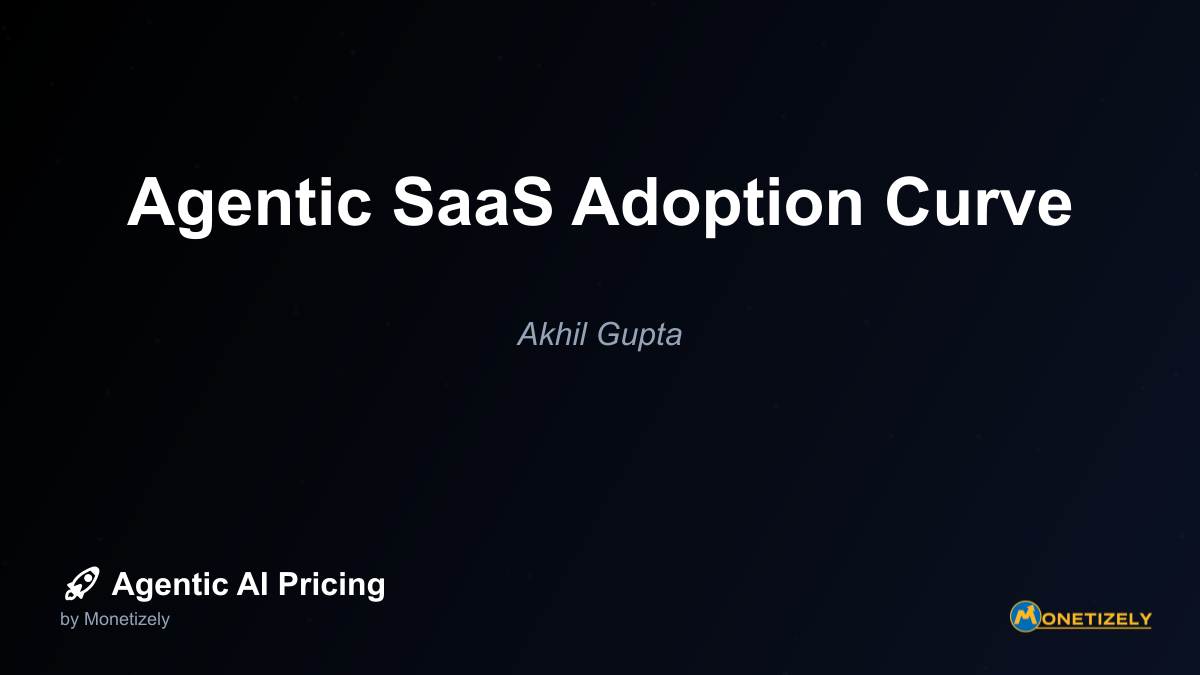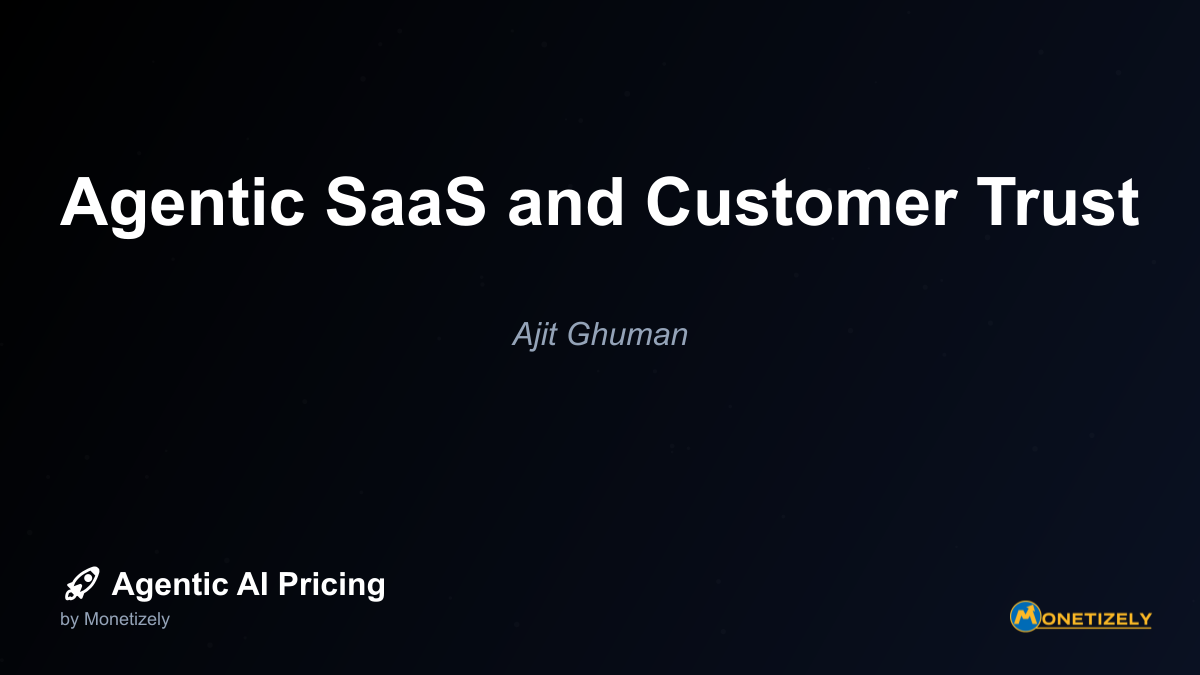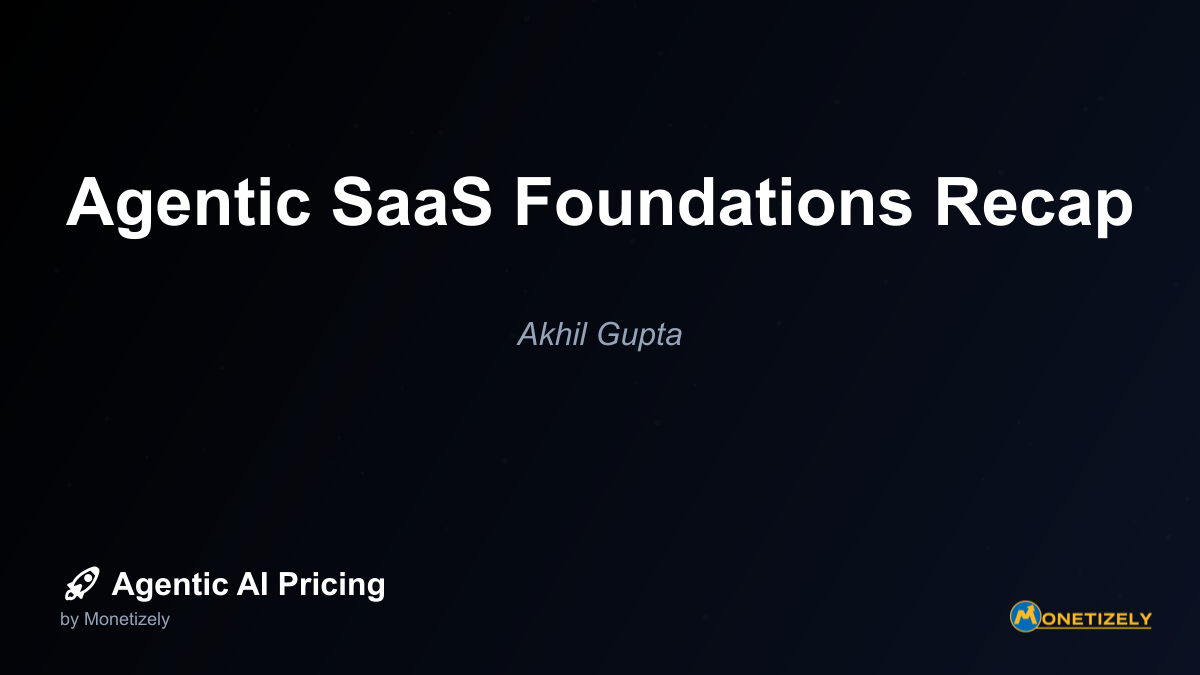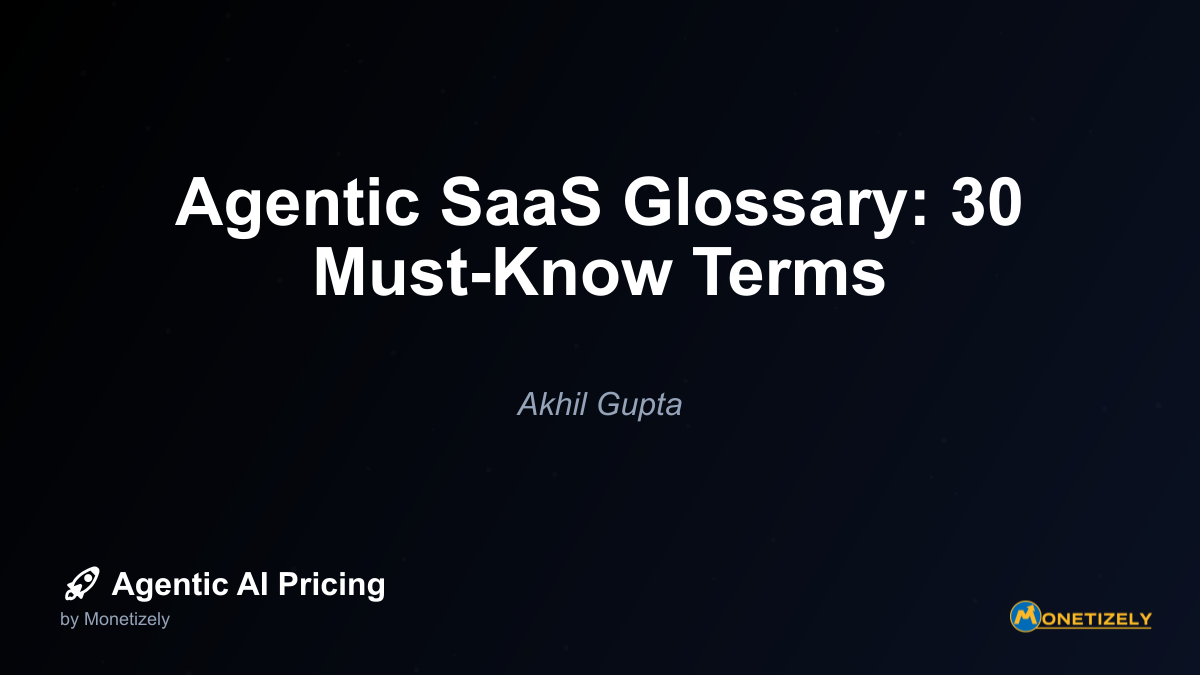· Akhil Gupta · Agentic SaaS Fundamentals · 13 min read
Agent Governance Models in SaaS
AI and SaaS Pricing Masterclass
Learn the art of strategic pricing directly from industry experts. Our comprehensive course provides frameworks and methodologies for optimizing your pricing strategy in the evolving AI landscape. Earn a professional certification that can be imported directly to your LinkedIn profile.
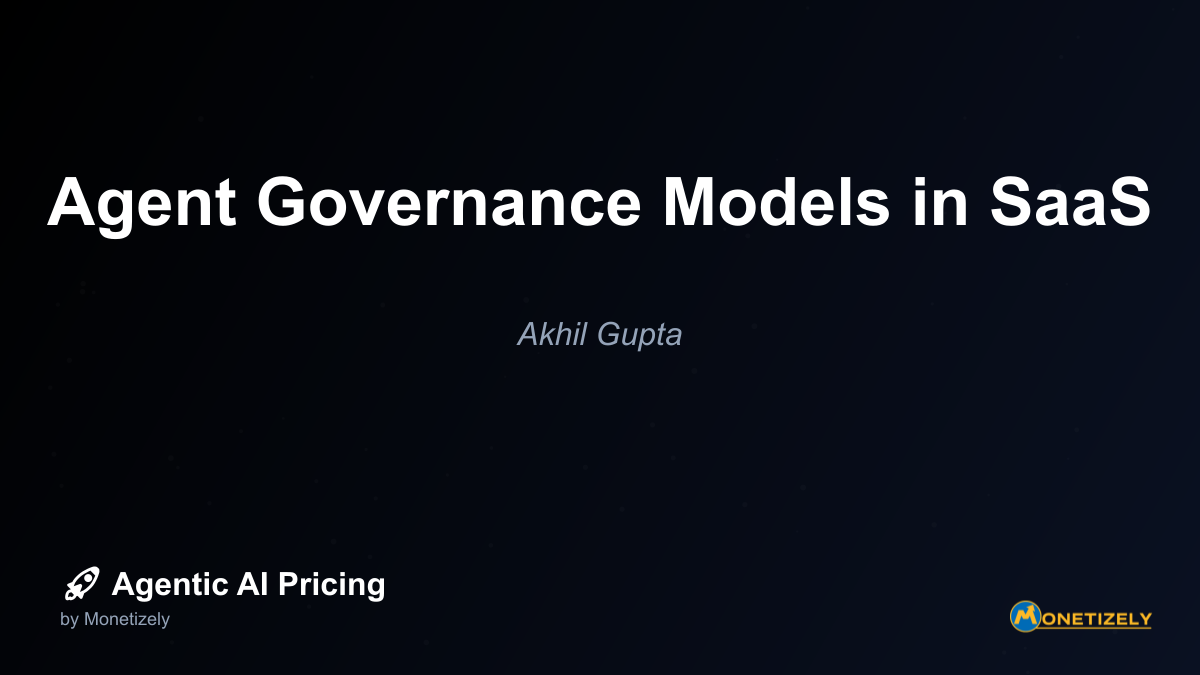
In today’s rapidly evolving technological landscape, autonomous AI agents are transforming how businesses operate. As these agents become more prevalent in SaaS environments, establishing robust governance models has emerged as a critical priority. Organizations must balance the transformative potential of AI agents with the need for control, compliance, and risk management. This comprehensive exploration examines the multifaceted approaches to agent governance in SaaS environments, offering strategic frameworks and practical guidance for implementing effective control mechanisms.
The Evolution of AI Agents in SaaS: From Assistants to Autonomous Workers
The transition from AI assistants to autonomous agents represents a fundamental shift in how software interacts with business processes. Unlike traditional AI tools that merely respond to specific queries, autonomous agents can initiate actions, make decisions, and execute complex workflows with minimal human intervention. This evolution brings unprecedented capabilities but also introduces new governance challenges.
According to recent market analysis, the adoption of agentic AI is accelerating rapidly. Gartner forecasts that by 2028, approximately 33% of enterprise software applications will incorporate agentic AI capabilities, a dramatic increase from less than 1% in 2024. This growth trajectory suggests that within a few years, AI agents will be responsible for approximately 15% of daily work decisions across organizations.
Microsoft, a leader in this space, has articulated a vision of AI agents as “digital labor” with defined identities and roles. Their 2025 Work Trend Index highlights the progression from assistants that respond to commands to autonomous digital colleagues capable of running entire business processes. This perspective fundamentally reshapes how organizations must approach governance.
The Core Components of Effective Agent Governance
Successful agent governance in SaaS environments requires a multi-layered approach that addresses several critical dimensions:
1. Identity and Access Management
At the foundation of agent governance lies a robust identity and access management framework. Unlike traditional user accounts, AI agents require specialized identity structures that:
- Define agent-specific digital identities
- Establish clear role boundaries and permissions
- Implement attribute-based access policies beyond classic role-based access control (RBAC)
- Enforce token-based authentication for secure agent operations
- Enable comprehensive audit trails for all agent activities
This identity-centric approach allows organizations to treat agents as accountable digital workers rather than merely features of a software platform. As noted in Microsoft’s Power Platform governance documentation, “Not every agent should have the same level of autonomy… CIOs should define tiers of autonomy and enforce them with technical guardrails. Just like you wouldn’t give a new hire full system access on day one, agents also need scoped permission and supervision.”
2. Tiered Autonomy Models
A one-size-fits-all approach to agent autonomy creates unnecessary risk. Leading organizations implement tiered autonomy models that calibrate an agent’s freedom to act based on:
- The sensitivity of the data being accessed
- The potential business impact of agent decisions
- The complexity of tasks being performed
- The maturity of the agent’s operating history
These tiers typically range from fully supervised agents that require human approval for all actions to highly autonomous agents permitted to execute complex workflows independently. The appropriate tier depends on both the use case and the organization’s risk tolerance.
3. Comprehensive Monitoring and Oversight
Effective governance requires continuous visibility into agent behaviors and outcomes. This monitoring layer serves multiple purposes:
- Real-time activity tracking: Capturing all agent actions and decisions as they occur
- Anomaly detection: Identifying unusual patterns or potential misuse
- Performance measurement: Evaluating agent effectiveness against defined metrics
- Compliance verification: Ensuring adherence to policies and regulations
- Audit support: Maintaining comprehensive records for review and investigation
Salesforce’s Agentforce implementation exemplifies this approach with enterprise-grade security controls that include event monitoring and anomaly detection through their Einstein Trust Layer to prevent unauthorized AI behavior.
4. Human-in-the-Loop Oversight Roles
Human oversight remains essential even for highly autonomous agents. Industry best practices define distinct human oversight roles:
- Reviewers: Validate AI-generated outputs for accuracy and appropriateness
- Monitors: Track agent actions continuously, enabling timely interventions
- Protectors: Restrict or adjust agent permissions to prevent misuse or errors
The case study of Nudge Security’s implementation demonstrates the value of this balanced approach. Their orchestrated system of automated nudges to SaaS users about inactive accounts effectively curbs SaaS sprawl while maintaining human decision-making in critical areas. This human-in-the-loop model solves governance challenges at scale while avoiding the limitations of purely automated solutions.
5. Technical Guardrails and Safety Mechanisms
Beyond policy frameworks, robust technical guardrails provide essential protection against agent errors or misuse. These guardrails include:
- Boundary enforcement: Hard limits on agent capabilities and actions
- Approval workflows: Required authorizations for high-impact decisions
- Circuit breakers: Automatic suspension of agent activities when anomalies are detected
- Rollback mechanisms: Capabilities to reverse agent actions when necessary
- Fail-safe defaults: Conservative behavior patterns when uncertainty arises
These technical controls serve as the last line of defense against unintended consequences, particularly in scenarios where agents operate with significant autonomy.
Implementation Challenges in Agent Governance
Organizations implementing agent governance frameworks face several significant challenges:
Integration Complexity
Enterprises report significant difficulties integrating AI agents with existing SaaS applications due to heterogeneous systems and data sources. According to industry research, effective AI agent governance demands integration with multiple data sources—often eight or more—which requires robust integration platforms like Integration Platform as a Service (iPaaS) solutions that can handle complex data flows securely and at scale.
This integration complexity often necessitates substantial investments in platform upgrades, middleware, and governance tooling. Surveys indicate that 68% of enterprises budget $500,000 or more annually on AI agent initiatives to cover these integration, infrastructure, and governance costs.
Shadow SaaS and Fragmented Control
The proliferation of unauthorized or unmanaged SaaS applications—often referred to as “shadow SaaS”—creates significant governance gaps. These unmanaged tools complicate identity and access management and increase risk exposure across the organization.
The State of SaaS 2025 Report reveals that SaaS companies are responding to this challenge by consolidating applications. The average number of SaaS apps per company decreased from 112 in 2023 to approximately 106 in 2025, reflecting a trend toward centralized IT controls to manage security and governance risks. Additionally, 78% of SaaS apps are now IT-sanctioned, and 41% of companies have increased IT management over SaaS apps, indicating stronger governance and risk control emphasis.
Standardization and Consistency
Maintaining consistent governance approaches across multiple SaaS environments presents ongoing difficulties. Organizations struggle with:
- Varying capabilities across different SaaS platforms
- Inconsistent API access for monitoring and control
- Disparate security models and authentication systems
- Platform-specific limitations on custom governance controls
These inconsistencies often lead to governance gaps where agents operating across multiple systems encounter different levels of oversight and control.
Technical Debt and Tool Limitations
Many organizations struggle with legacy tools and existing governance frameworks that do not scale well to SaaS and AI agent demands. This technical debt complicates governance implementation and often necessitates the adoption of modern SaaS Management Platforms (SMPs) or specialized identity governance solutions.
Manual governance methods fail at scale and entail high operational overhead, making automation platforms a more cost-effective long-term solution despite upfront investments. However, the transition to these modern tools often requires significant organizational change management.
Strategic Frameworks for Agent Governance Implementation
Implementing effective agent governance requires a structured approach. The following framework provides a strategic roadmap:
1. Assessment and Discovery
Begin with a comprehensive assessment of your current SaaS environment and agent usage:
- Inventory existing agents: Document all AI agents currently in use, including their capabilities, access levels, and business functions.
- Map data flows: Understand how data moves between agents and other systems.
- Identify governance gaps: Evaluate current controls against best practices to identify areas for improvement.
- Assess risk profiles: Categorize agents based on their potential business impact and security implications.
This discovery phase establishes the foundation for a targeted governance strategy.
2. Policy Development
Develop comprehensive governance policies that address:
- Agent classification: Define categories of agents based on function, capability, and risk profile.
- Autonomy guidelines: Establish clear parameters for agent decision-making authority.
- Approval processes: Document required authorizations for agent deployment and modification.
- Monitoring requirements: Specify the types and frequency of agent activity reviews.
- Incident response: Detail procedures for addressing agent malfunctions or policy violations.
- Compliance alignment: Ensure policies reflect relevant regulatory requirements.
These policies should be developed collaboratively with input from IT, security, legal, and business stakeholders.
3. Technical Implementation
Deploy the technical infrastructure required to enforce governance policies:
- Identity management systems: Implement solutions for agent identity and access control.
- Monitoring platforms: Deploy tools for continuous visibility into agent activities.
- Integration middleware: Establish connections between agents and governance systems.
- Security controls: Implement encryption, authentication, and other protective measures.
- Audit mechanisms: Create comprehensive logging and reporting capabilities.
The technical implementation should prioritize automation to ensure governance scales effectively as agent usage grows.
4. Operational Model
Establish the operational structures needed to maintain governance over time:
- Governance committee: Form a cross-functional team responsible for oversight.
- Review cadence: Schedule regular evaluations of agent performance and compliance.
- Continuous improvement: Create mechanisms to refine governance based on outcomes.
- Training programs: Develop education for both technical teams and business users.
- Feedback channels: Establish methods for reporting concerns or improvement ideas.
This operational model ensures that governance remains effective as both technology and business needs evolve.
Case Studies in Agent Governance
Examining real-world implementations provides valuable insights into effective governance approaches:
Zenity’s SaaS AI Agent Governance
Zenity provides a specialized governance layer for AI agents embedded in popular SaaS platforms like Microsoft 365 Copilot, ChatGPT Enterprise, and Salesforce Agentforce. Their implementation focuses on:
- Full visibility into agent actions behind the scenes, including data access, workflows, and agent interactions
- Policy enforcement and runtime monitoring to prevent data leakage and unauthorized activity
- Real-time alerts on risky behavior that deviates from established policies
This governance approach has successfully helped organizations detect unauthorized agents created without approvals and monitor AI decisions involving sensitive data such as personally identifiable information (PII) and financial records. The implementation demonstrates how governance enables SaaS AI innovation without compromising security.
Microsoft’s Power Platform Governance for AI Agents
Microsoft has developed a comprehensive governance framework for AI agents within their Power Platform ecosystem. Their approach includes:
- Treating agents as digital labor with defined identities and roles
- Enforcing tiers of autonomy based on risk profiles
- Implementing distinct oversight roles (review, monitor, protect)
- Integrating agent governance into broader business workflows
Microsoft’s framework exemplifies the evolution from basic controls to sophisticated governance that addresses the unique challenges of autonomous agents. Their tiered approach to autonomy demonstrates how governance can be calibrated to different risk levels and use cases.
Salesforce’s Agentforce Security Implementation
Salesforce has implemented enterprise-grade security controls layered on their shared security model for their Agentforce offering. Key elements include:
- Attribute-based policies beyond classic role-based access control
- Token authentication for secure agent operations
- Comprehensive encryption for sensitive data
- Event monitoring for continuous visibility
- Anomaly detection through their Einstein Trust Layer
This implementation showcases how established SaaS providers are adapting their security models to address the unique challenges of autonomous agents. Salesforce’s approach integrates agent governance into their broader security architecture, providing consistent protection across their platform.
The Future of Agent Governance in SaaS
Looking ahead, several emerging trends will shape the evolution of agent governance:
Multi-Agent Governance Complexity
As organizations deploy multiple agents that interact with each other, governance models must adapt to monitor and control these complex interactions. Future governance frameworks will need to address:
- Agent-to-agent communications and dependencies
- Collective decision-making across agent networks
- Cascade effects when one agent influences others
- Distributed responsibility in multi-agent systems
This increasing complexity will drive more sophisticated governance approaches that consider not just individual agents but entire agent ecosystems.
Vertical and Domain-Specific Governance
Industry-specific requirements will increasingly influence governance models. In heavily regulated sectors like healthcare, finance, and government, specialized governance frameworks will emerge that address:
- Sector-specific compliance requirements
- Industry data handling standards
- Domain-specific risk profiles
- Specialized audit and reporting needs
These vertical governance models will enable organizations to balance innovation with compliance in their specific regulatory contexts.
AI-Driven Governance
Ironically, AI itself will play an increasingly important role in governing AI agents. Advanced governance platforms will leverage AI capabilities to:
- Predict potential governance issues before they occur
- Automatically adjust agent permissions based on behavior patterns
- Identify subtle anomalies that might indicate misuse
- Optimize governance controls for maximum effectiveness with minimum friction
This evolution toward AI-driven governance represents a natural progression as organizations seek to scale oversight alongside growing agent deployments.
Integration with Broader Enterprise Governance
Agent governance will increasingly integrate with broader enterprise governance frameworks, including:
- Enterprise risk management
- Corporate compliance programs
- Data governance initiatives
- Third-party risk management
- Business continuity planning
This integration will ensure that agent governance aligns with overall organizational priorities and control structures.
Developing a Comprehensive Agent Governance Strategy
Based on current best practices and emerging trends, organizations should consider the following elements when developing their agent governance strategy:
1. Establish Clear Ownership and Accountability
Designate specific roles and responsibilities for agent governance:
- Executive sponsor: Senior leader responsible for overall governance direction
- Governance committee: Cross-functional team overseeing implementation
- Technical owner: Individual responsible for governance infrastructure
- Business stakeholders: Representatives from departments using agents
- Compliance liaison: Connection to legal and regulatory functions
Clear accountability ensures that governance remains a priority and receives appropriate resources.
2. Implement a Risk-Based Approach
Not all agents require the same level of governance. Categorize agents based on:
- Data sensitivity: The nature of information the agent accesses
- Business impact: The potential consequences of agent decisions
- Autonomy level: The degree of independent action permitted
- Scale of operation: The breadth of the agent’s activities
This risk-based approach allows organizations to focus governance resources where they matter most.
3. Develop Comprehensive Monitoring Capabilities
Effective monitoring forms the foundation of agent governance. Implement monitoring that covers:
- Activity logging: Detailed records of all agent actions
- Performance metrics: Measurements of agent effectiveness
- Compliance checks: Verification of policy adherence
- Anomaly detection: Identification of unusual patterns
- User feedback: Collection of stakeholder observations
These monitoring capabilities provide the visibility needed for effective oversight.
4. Create Clear Intervention Protocols
Establish documented procedures for addressing governance issues:
- Issue classification: Framework for categorizing governance concerns
- Escalation paths: Defined routes for raising and addressing issues
- Remediation actions: Specific steps for resolving different problems
- Emergency responses: Procedures for critical governance failures
- Communication templates: Standardized messaging for governance events
These protocols ensure consistent and timely responses to governance challenges.
5. Design for Continuous Improvement
Build mechanisms for ongoing governance enhancement:
- Regular reviews: Scheduled evaluations of governance effectiveness
- Feedback loops: Channels for stakeholder input on governance
- Metrics and benchmarks: Quantitative measures of governance performance
- Adaptation processes: Methods for updating governance approaches
- Knowledge sharing: Systems for disseminating governance insights
This commitment to continuous improvement ensures that governance evolves alongside agent capabilities and organizational needs.
Balancing Innovation and Control
The ultimate challenge in agent governance is striking the right balance between enabling innovation and maintaining appropriate control. Organizations that implement overly restrictive governance may limit the transformative potential of AI agents, while those with insufficient controls face significant risks.
Successful organizations approach this balance by:
- Starting conservatively: Implementing strong controls initially and gradually relaxing them as experience grows
- Piloting innovations: Testing new agent capabilities in controlled environments before broader deployment
- Measuring outcomes: Evaluating both the benefits and risks of different governance approaches
- Learning incrementally: Building governance knowledge through progressive expansion
- Adapting contextually: Tailoring governance to specific use cases and environments
This balanced approach enables organizations to capture the value of AI agents while managing the associated risks effectively.
Conclusion: The Path Forward for Agent Governance
As AI agents become increasingly central to SaaS environments, governance will emerge as a critical success factor. Organizations that establish robust, balanced governance frameworks will be positioned to leverage the full potential of autonomous agents while managing the associated risks.
The most successful governance approaches will be those that evolve alongside agent capabilities—adapting to new technologies, use cases, and regulatory requirements. Rather than viewing governance as a constraint, forward-thinking organizations will recognize it as an enabler that creates the trust and control needed for widespread agent adoption.
By implementing the frameworks, strategies, and best practices outlined in this exploration, organizations can establish governance models that support their AI agent initiatives today and adapt to the challenges of tomorrow. In doing so, they will unlock the transformative potential of autonomous agents while maintaining the control needed for responsible innovation.
The journey toward effective agent governance is not a destination but an ongoing process of refinement and adaptation. Organizations that commit to this journey will find themselves well-positioned to thrive in the emerging era of autonomous SaaS.
Read MoreCo-Founder & COO
Akhil is an Engineering leader with over 16+ years of experience in building, managing and scaling web-scale, high throughput enterprise applications and teams. He has worked with and led technology teams at FabAlley, BuildSupply and Healthians. He is a graduate from Delhi College of Engineering and UC Berkeley certified CTO.
Pricing Strategy Audit
Let our experts analyze your current pricing strategy and identify opportunities for improvement. Our data-driven assessment will help you unlock untapped revenue potential and optimize your AI pricing approach.

